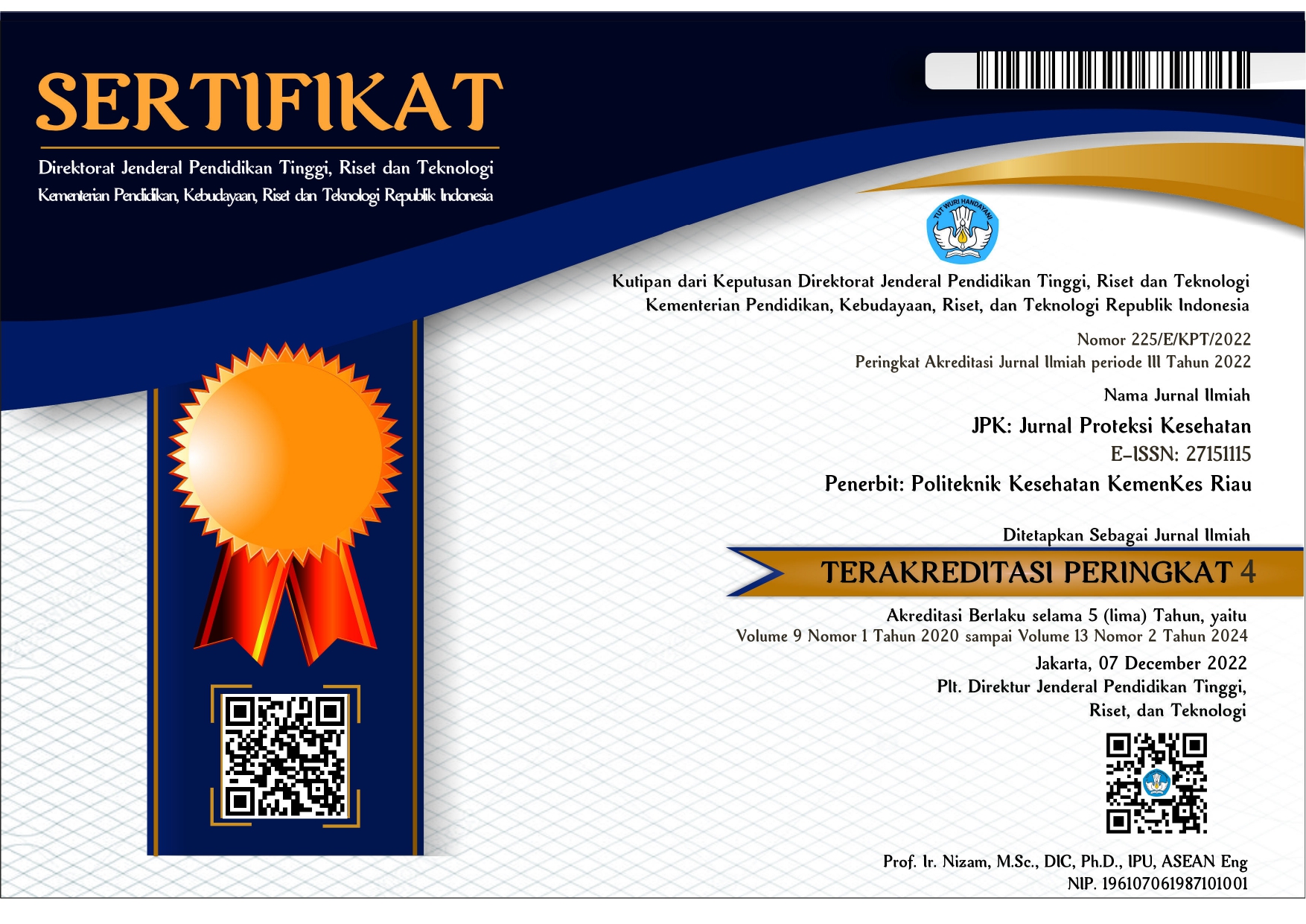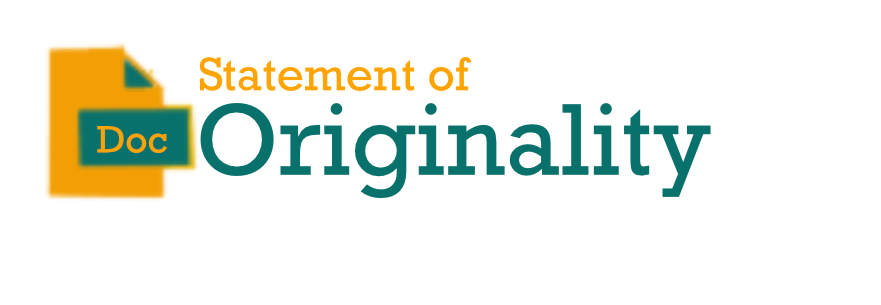Hygiene Sanitation and Identification of Escherichia coli in Fresh Goat Milk
Abstract
Fresh milk is the result of the milking process and has not received any treatment except cooling. Its high nutritional value causes milk to become a very suitable medium for microorganisms growth and development so that in a very short time milk becomes unfit for consumption. One example of this bacterium is Escherichia coli (E. coli). This study aims to determine the description of hygiene and sanitation and the identification of Escherichia coli. This study is survey research and qualitative descriptive. The sampling method of fresh goat's milk is using the total sampling method. The samples in this study were 2 fresh goat's milk at the farms of Umban Sari Rumbai and Sidomulyo barat Pekanbaru city. The results of this study indicate that the hygiene and sanitation of farm A (Umban Sari) are in agood category, while farm B (Sidomulyo barat) only has good sanitation of cages and equipment. The results of the identification of E. coli from the two farms showed that there was no contamination of E. coli bacteria in fresh goat's milk. It was found that farm hygiene did not meet the hygiene requirements and obtained laboratory results that Escherichia coli bacteria were not found in fresh goat's milk. Further analysis can be conducted to the other kind of coliform bacteria.
References
[2] Zakaria, Y., Yahya, H. M., & Safara, Y., Analisa Kualitas Susu Kambing Peranakan Etawah yang Disterilkan pada Suhu dan Waktu yang Berbeda, Jurnal Agripet, 11(1), 29–31, 2011
[3] Zain, W. N. H., Kualitas Susu Kambing Segar di Peternakan Umban Sari Dan Alam Raya Kota Pekanbaru, Jurnal Peternakan, 10(1), 24–30, 2013
[4] Hijriah, Pione Firbarama. Santosa, Purnama Edy. & Wanniatle, V., Status Mikrobiologi (Total Plate Count, Coliform, dan Escherichia Coli) Susu Kambing Peranakan Etawa (PE) di Desa Sungai Langka Kecamatan Gedong Tataan Kabupaten Pesawaran, Jurnal Ilmiah Peternakan Terpadu, 4(3), 217–221, 2016
[5] Yusuf, Achmad, Kentjonowaty, I., & Humaidah, N., Pengaruh Higiene Pemerahan Terhadap Jumlah Mikroba dan pH Susu Sapi Perah, Dinamika Rekasatwa, 4(1), 12–17, 2021
[6] Suwito, W., Winarti, E., Kristiyanti, F., Widyastuti, A., & Andriani, A., Faktor Risiko terhadap Total Bakteri , Staphylococcus aureus , Coliform , dan Escherichia coli pada Susu Kambing, Agritech, 38(1), 39–44, 2018
[7] ISO 9001. Validated from AOAC International Methods Committe Guidelines for Validation of Microbiological Methods for Food and Environmental Surfacs.
[8] Peraturan Menteri Pertanian Republik Indonesia, Nomor 26/Pementan/PK.450/7/2017 tentang Penyediaan dan Peredaran Susu, 2017
[9] FAO-Food and Agriculture Organization, Guide to Good Dairy Farming Practice. In Animal Production and Health Guidelines, 2011
[10] Novita L, dkk, Gambaran pengetahuan dan sikap penjamah makanan tentang personal higiene pada 3 pedagang di kantin Poltekkes Kemenkes Riau, Jurnal ibu dan anak, 6(2), 2018
[11] Parapat, Mustika Delima, Higiene Sanitasi pada Pemerahan Susu Kambing dan Pemeriksaan Bakteri Salmonella Sp. pada Susu Kambing di Kabupaten Deli Serdang Tahun 2013, Skripsi, 2013
[12] Rahayu, W.P, Nurjanah, S., & Komalasari, E., Escherichia coli : Patogenitas, Analisis dan Kajian Risiko, Bogor: Percetakan IPB, 2018
[13] Kumala, R R., Hubungan Higiene Sanitasi Pemerah Susu Sapi dengan Keberadaan Bakteri Coliform di Desa Bedrug Kecamatan Pulung Kabupaten Ponogoro, Skripsi, 2018
[14] Sanam, A. B., Bagus, I., & Swacita, N., Ketahanan Susu Kambing Peranakan Ettawah Post-Thawing pada Penyimpanan Lemari Es Ditinjau dari Uji Didih dan Alkohol, Medicus Veterinus, 3(1), 1–8, 2014
[15] Setiyawati, I., Keamanan Pangan (Sanitasi, Higienis, Dan Keselamatan Kerja), Quantum Book, 2020
[16] Ilhamsyah, A., Gambaran Sanitasi Kandang Ternak Sapi dengan Kualitas Air Sumur Gali di Desa Pendem Kecamatan Kembang Kabupaten Jepara, Thesis Universitas Negeri Semarang, 2015
[17] Affan, I., Razali, & Rastina, Jumlah Cemaran Total Plate Count (TPC) dan Escherichia Coli Susu Kambing Segar yang Berasal Dari Usaha Ternak Kambing Perah di Kecamatan Syiah Kuala Banda Aceh, Jurnal Ilmiah Mahasiswa Veteriner, 2(01), 17–22, 2017
[18] Sulasih, Priyono, & Mudawaroch, Roisu Eni, Pengaruh Lama Penyimpanan pada Suhu (- 20C) terhadap Jumlah Total Bakteri (TPC) Susu Kambing Peranakan Etawah, Surya Agritama: Jurnal Ilmu Pertanian, 2(2), 59-67, 2013
[19] Chrisna Wulandari, D., Nurdiana, N., & Rahmi, Y., Identifikasi Kesempurnaan Proses Pasteurisasi Ditinjau dari Total Bakteri serta Kandungan Protein dan Laktosa pada Susu Pasteurisasi Kemasan Produksi Pabrik dan Rumah Tangga di Kota Batu, Majalah Kesehatan, 3(3), 144–151, 2016 https://doi.org/10.21776/ub.majalahkesehatan.003.03.5
[20] Nurliyani, Hasil Olahan Susu Skim Cair, 1–38, 2012












